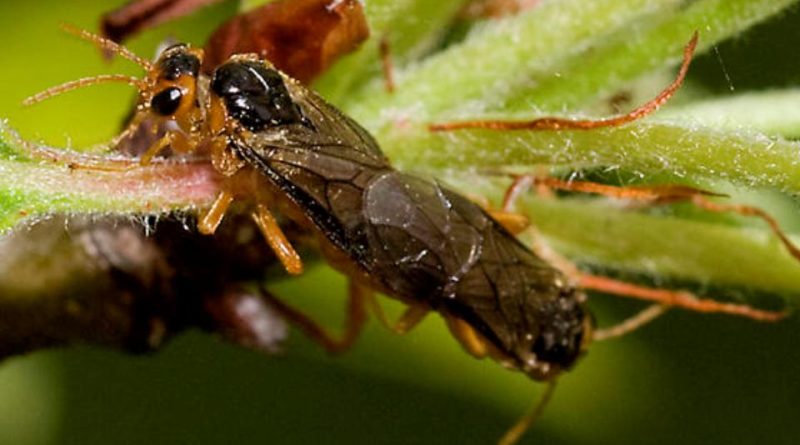Hoplocampa testudinea
Hoplocampa testudinea
The European apple sawfly (Hoplocampa testudinea Klug, 1816) is an insect belonging to the Tenthredinidae family.
Systematics –
From a systematic point of view it belongs to:
Eukaryota Domain,
Kingdom Animalia,
Sub-kingdom Eumetazoa,
Bilateria branch,
Phylum Arthropoda,
Subphylum Tracheata,
Superclass Hexapoda,
Insecta class,
Subclass Pterygota,
Endopterygota cohort,
Superorder Oligoneoptera
Hymenopteroidea section,
Order Hymenoptera,
Symphyta suborder,
Superfamily Tenthredinoidea,
Tenthredinidae family,
Genus Hoplocampa,
H. testudinea species.
Geographic Distribution and Habitat –
The European apple sawfly is a hymenopteran native to Europe but accidentally introduced in other areas, such as in North America (detected for the first time in 1939), where it has become invasive.
Its distribution is European, up to Great Britain and in the continent of North America up to the northernmost areas (between 60 ° and 40 ° north latitude).
Its preferential habitat is that corresponding to the apple growing areas.
Morphology –
Hoplocampa testudinea is an insect which, at the adult stage, is 6 to 7 mm long. it has a bright black dorsal part, while the ventral one is yellowish-brown in color.
The head has a yellowish tint.
The wings are folded horizontally on the back and are hyaline with brown ribs.
The larvae are 12 – 14 mm long and are whitish in color with a brown head. They have 7 pairs of abdominal legs and give off a characteristic smell of bedbugs.
Attitude and Life Cycle –
Hoplocampa testudinea begins its cycle in spring when it appears in the adult stage and is attracted to the flowering of apple trees.
At this moment the females lay their eggs on the open flowers in slits obtained just under the calyx; usually one egg per flower. The eggs hatch after 8-18 days depending on the temperature when 80% of the petals have fallen, and the newly hatched larvae make their way into the small immature fruits, first burrowing under the epidermis and then digging in the center. As they get bigger, they tunnel outward and move into an adjacent fruit tree, creating a large entry hole that gets clogged with brown, sticky droppings. When their development is complete and they have dug into several fruits, the damaged apples fall to the ground.
The larva then leaves the fruit making a wide orifice with very sharp edges; it drops to the ground and sinks to 5-10 cm to weave a silky cocoon in which it remains in diapause from 9 to 21 months. The nymph is formed in the period of March / April.
In this way, there is only one generation per year.
Ecological Role –
The European apple sawfly is an insect that in the presence of high populations can cause serious damage to apple crops.
This insect is favored by intensive cultivation and the most severely damaged fruits fall from the tree. In addition, some apple varieties are more sensitive.
In European areas, from where the insect spread, there are various predators and natural parasites.
These include:
– Aptesis nigrocincta, parasite;
– Aspergillus flavus, antagonist;
– Beauveria bassiana, pathogen;
– Lathrolestes ensator, parasite;
– Lathrolestes marginatus, parasite;
– Lecanicillium lecanii, pathogen;
– Metarhizium anisopliae, pathogen;
– Paecilomyces farinosus, pathogen;
– Paecilomyces fumosoroseus, pathogen.
In particular, the parasitoid Lathrolestes ensator, which is a parasite of larvae, can play an important role.
In North America, these natural enemies are not present and the pest causes more significant damage to apple crops. In an attempt to alleviate this situation, L. ensator was imported from Europe to serve as a control.
In the containment of Hoplocampa testudinea, adhesive traps can also be used that can be used to capture adults to monitor infestation levels in order to assess whether the intervention threshold is exceeded.
The intervention threshold is 20 – 30 adults / flowering trap.
Furthermore, research is being carried out in the biological control using the entomogenic nematodes Steinernema carpocapsae, Steinernema feltiae and Heterorhabditis bacteriophora.
Among the active ingredients it has been seen that quassin and neoquassin, extracted from Quassia amara, can control H. testudinea in organic farming.
Research is also being carried out with entomopathogenic fungi.
Chemical treatments are recommended only where there has been a strong attack the previous year and where adults are already above the tolerance threshold of the current year.
Guido Bissanti
Sources
– Wikipedia, the free encyclopedia.
– Russo G., 1976. Agricultural Entomology. Special Part. Liguori Editore, Naples.
– Pollini A., 2002. Manual of applied entomology. Edagricole, Bologna.
– Tremblay E., 1997. Applied entomology. Liguori Editore, Naples.
Photo source:
– https://bugguide.net/node/view/745582

